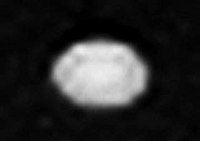Despina or Neptune V is the third closest moon to Neptune. It is named after Despina, a nymph who was a daughter of Poseidon.
 Despina as seen by Voyager 2 (smeared horizontally) | |
| Discovery | |
|---|---|
| Discovered by | Stephen P. Synnott |
| Discovered in | July 1989 |
| Orbital characteristics | |
| Epoch 18 August 1989 | |
| Semi-major axis | 52 526 ± 1 km |
| Eccentricity | 0.0002 ± 0.0002 |
| Orbital period | 0.33465551 ± 0.00000001 d |
| Inclination | 0.216 ± 0.014° (to Neptune equator) 0.06° (to local Laplace plane) |
| Is a moon of | Neptune |
| Physical characteristics | |
| Dimensions | 180×150×130 km |
| Mass | ~2.1×1018 kg (based on assumed density) |
| Mean density | ~1.2 g/cm3 (estimate) |
| Rotation period | assumed synchronous |
| Axial tilt | ~zero presumably |
| Albedo (geometric) | 0.09[1] |
| Surface temp. | ~51 K mean (estimate) |
| Atmosphere | none |
Despina was found in late July 1989 from the images taken by the Voyager 2 probe. It was given the designation S/1989 N 3.
Despina is not a sphere and shows no sign of any geological changes.
Other websites
change- Despina Profile Archived 2007-08-01 at the Wayback Machine by NASA's Solar System Exploration
References
change- ↑ E. Karkoschka (2003). "Sizes, shapes, and albedos of the inner satellites of Neptune". Icarus. 162 (2): 400–407. Bibcode:2003Icar..162..400K. doi:10.1016/S0019-1035(03)00002-2.